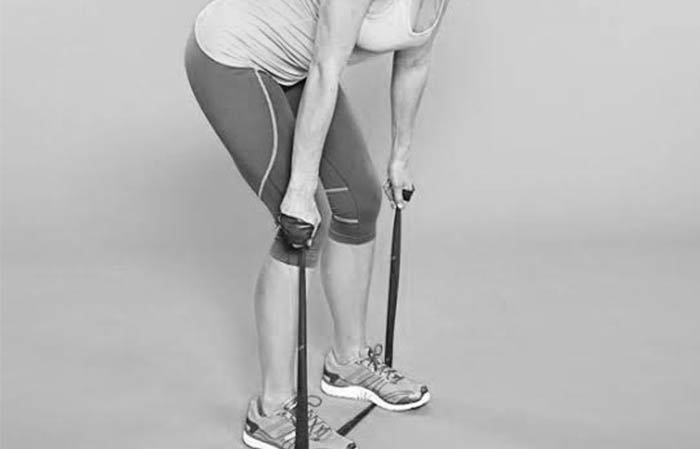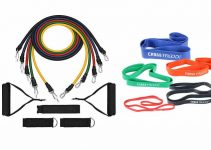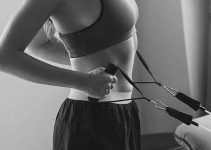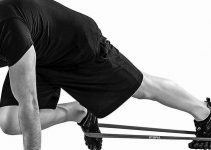The deadlift is an exercise in which you bend and lift up your body in various forms. Often, weights are used to attain the desired results. In the place of weights, you can use resistance bands which offer a more controlled way to work out thus avoiding injuries. They’re also cheaper than going to a gym.
With resistance bands, you can perform conventional deadlifts, sumo deadlifts, Romanian deadlifts, stiff-legged deadlifts, hex/trap bar deadlifts, snatch grip deadlifts, deficit deadlifts, block pull deadlifts, single leg deadlifts, and the t-bar row with band.
These deadlifts vary by a small extent with the main difference being where your hands are placed relative to your body. Other variations include the space between your legs and how you perform each exercise.
Note: For some of these exercises, you will need anchors to reproduce the same effect you get when using weights.
1. Conventional Deadlifts
Whether you’re just starting off doing deadlifts or a seasoned exercise freak, the conventional deadlift never fails to yield results. They focus on the calves, glutes, lats, quads, the lower back, forearms, hamstrings, the middle back and the traps.

With a resistance band, they’re done as follows:
- Stand with your feet shoulder width apart then loop the resistance band below both feet. Take the ends of the band in both of your hands from outside your body. The palms should face backwards.
- At the starting point, your body should be bending forward such that your hands are directly above your hands and they’re also perpendicular to the ground. Your back should be inclined at a 45-degree angle to the ground.
- From this point, pull the ends of the bands upwards until your body is straight upwards. As you do that, ensure the palms of your hands go directly up.
You should be careful not to put all the weight on your back. Rather, distribute it with the majority of it falling on your thigh muscles.
Perform 3 sets of 15 reps each.
2. Sumo Deadlifts
You know how sumo wrestlers stand just before they clash with each other? The sumo deadlift is based on that specific stance. The stance entails standing with your feet wider than your body and lifting the load from directly below you.
It’s done as follows:
- Stand with your feet as far wide as comfortably possible then loop the band under both feet. Ensure there’s tension in the band at the starting point.
- Bend and pick up the middle of the band at points that are shoulder width apart. Ensure that your upper body and thighs form 45 degree angles to the ground at the starting position. Also, make sure one palm is facing forwards and the other one backwards.
- Like in the conventional deadlift, pull the bands straight upwards as you raise your body and stand straight. Return to the starting position to complete the rep.
Also perform 3 sets of 15 reps each then switch the direction of your palms.
3. Romanian Deadlifts
The difference between the Romanian deadlift and the others is that you don’t bend your knees. In that position, your target areas are the upper and lower back, glutes, hamstrings and the core.
It’s performed as follows:
- Stand such that your feet are straight up and legs are perpendicular to the ground. The feet should be shoulder width apart and the knees very slightly bent just for stability. Ideally, they should be straight.
- Loop the band below the feet and grab the ends of the band as you did in the conventional deadlift. From the starting position, your back should be almost horizontal.
- Slowly stand up while pulling the ends of the band until almost straight then start returning to the original position for a single rep.
Throughout the exercise, your knees should not bend at all. For this exercise as well, perform 3 sets of 15 reps each.
4. Stiff-legged Deadlifts
Stiff-legged deadlifts are very much similar to the Romanian deadlifts save for the angle of bending on your back and the fact that the knees are bent a little more. The rest of the exercise is the same as shown in the steps below:
- Stand with your feet shoulder width apart and loop the band below the feet. Hold the ends of the band in your hands.
- In the starting position, bend until your back is almost horizontal to the ground.
- Lift your upper body upwards as you pull on the bands until you’re almost straight up then return to the starting point to complete the rep.
In this deadlift as well, you don’t move any part of the feet at all. Perform 3 sets of 25 reps each.
5. Hex/Trap Bar Deadlifts
The hex or trap bar deadlifts are named after the type of gym equipment used to perform it.
In this deadlift, you lift up on the trap bar with your palms facing your body and the distance between the palms maintained all throughout the exercise.

With a resistance band, you replicate this exercise as follows:
- Anchor the band below your legs with the anchor points being slightly wider than your shoulder width. Hold the ends of the band in both arms with the palms facing one another. Ensure that you grip the band’s ends directly above the anchors.
- You can also use any other flat object like a weight disk as an anchor
- Go into a half squat with your feet shoulder width apart then start moving to the standing position while pulling on the band. As you pull upwards, ensure that your hands remain away from the body and directly above the anchor points.
Perform 3 sets each with 15 reps for a start.
6. Snatch Grip Deadlifts
The snatch grip deadlift is what you observe in the Olympic Games’ weightlifting competitions. In this type of deadlift, you place your hands as far away from your body as possible.
It’s a difficult one to pull off especially given that the point of contact with the band is away from your body’s center of gravity.
It’s performed as follows:
- Move the anchor points from the hex deadlift above as far away from your body as possible. The recommended distance should be ¾ the length of your arm either side. Anchor the band(s) at these points then hold the ends with both of your hands.
- Assume a half squat position then slowly raise your body until you’re standing up straight. Ensure that the distance between your body and the arms is maintained throughout the exercise.
Perform 15 reps for each of the 3 sets.
7. Deficit Deadlifts
Deficit deadlifts are a combination of the sumo deadlift and the conventional deadlift.
It’s a good point to start doing a deadlift if you’re having trouble doing it the conventional way. This is because you stand on a small platform which makes it easy to bear the weights in the early stages of the deadlift.
It’s done as follows:
- Stand with your feet shoulder width apart and with the band anchored at a distance slightly wider than your shoulder width. To attain this, you can take a piece of wood about 4 inches thick and wider than your shoulder width and stand on it. Loop the band under it to act as the anchor points.
- Hold the ends of the band with one palm facing forwards and the other backwards.
- At the starting position, you should be in a half squat position with the back and upper legs forming 45-degree angles to the ground each.
- Pull the ends of the band upwards as you raise into an upright position then return to the half squat position to complete the rep.
Perform 3 sets of 15 reps each.
8. Block Pull Deadlifts
In more effort to help you attain your workout targets, the block pull deadlifts are meant to reduce the load of the weights or band resistance at the start of the deadlift. This is achieved through elevating the resting position of the weights in a typical deadlift such that you pick it up a short distance from the ground.
With a resistance band, you do it as follows:
- Anchor the bands about 4 inches off the ground such that they’re closer to the palms than before.
- Stand with your feet shoulder width apart and grab the ends of the bands from outside your body but close to it as well.
- Assume the half squat position then slowly move the body to an upright position while keeping the hands straight.
For the best benefits, ensure that the bands have tension at the starting position. Perform 3 sets of 15 reps each for this exercise as well.
9. Single Leg Deadlifts
Single leg deadlifts work on your glutes, core and hamstrings when done correctly. It’s basically doing a deadlift on one leg with the other aspects remaining the same as shown below:
- Start with your feet together and band anchored on two points on the ground. Your feet should be right in the middle of the band.
- Bend forward such that your upper body and legs form a 90-degree angle.
- Stretch one of your legs backwards such that it forms a straight line from your head through your hip area to the leg.
- Pick up the middle of the band with both hands and lift it upwards until your body is upright and return to the starting point for a single rep.
This too should be performed in 3 sets of 15 reps each.
10. T-bar Row with Band
Performing a T-bar row entails lifting one side of an anchored and weighted bar in between one’s legs. To do this, you face the end away from the anchor then lift the loose end of the bar up and down to complete a rep.
Replicating that with a resistance band is as follows:
- Anchor one end of a metal pole about your height long. Allow the pole to move up and down on the loose end.
- At the loose end of the pole, anchor the band at two points with the pole underneath the middle of the band.
- Stand over the pole facing the loose side of it then go to a half squat position with your hands holding the pole about ¾ to the loose end with the band.
- Pull on the band while transferring the weight to the lower back and glutes until you’re standing straight up. Return to the starting point for a single rep.
Perform 10 to 15 reps of this workout and do sets of each.
These workouts are good for your whole body if done correctly and on a frequent basis. As with all exercises, consistency is the key to great results.
Best Bands
The five best resistance bands for beginners include the following:
1. Tribe Resistance Bands Set
2. REEHUT Single Resistance Band
3. Lim Resistance Bands Exercise Loops
4. FOMI 7 Ring Stretch and Resistance Exercise Band
5. Koncle 11 pcs Resistance Band Set
These bands are affordable yet of a very high quality.
Further Reading
- Resistance Bands Basics: Meaning, Types, how they Work + Benefits
- Resistance Band vs Free Weights
- Best Beginner Resistance Band Exercises
- Resistance Band Exercises for Knees
- Pilates Resistance Band Exercises
- Best Ankle Resistance Band Exercises
- Best Senior Seated Band Exercises
- Best Shoulder Resistance Band Exercises
- Chest Resistance Band Exercises for Men
- Glute/Butt Resistance Band Exercises for Women
- Upper and Lower Back Band Exercises
- Resistance Band Exercises for Arms(Biceps & Triceps)
- Best Resistance Band Abs Exercises
- Best Resistance Band Leg Exercises



It’s going to be ending of mine day, however before ending I
am reading this great paragraph to improve my knowledge.